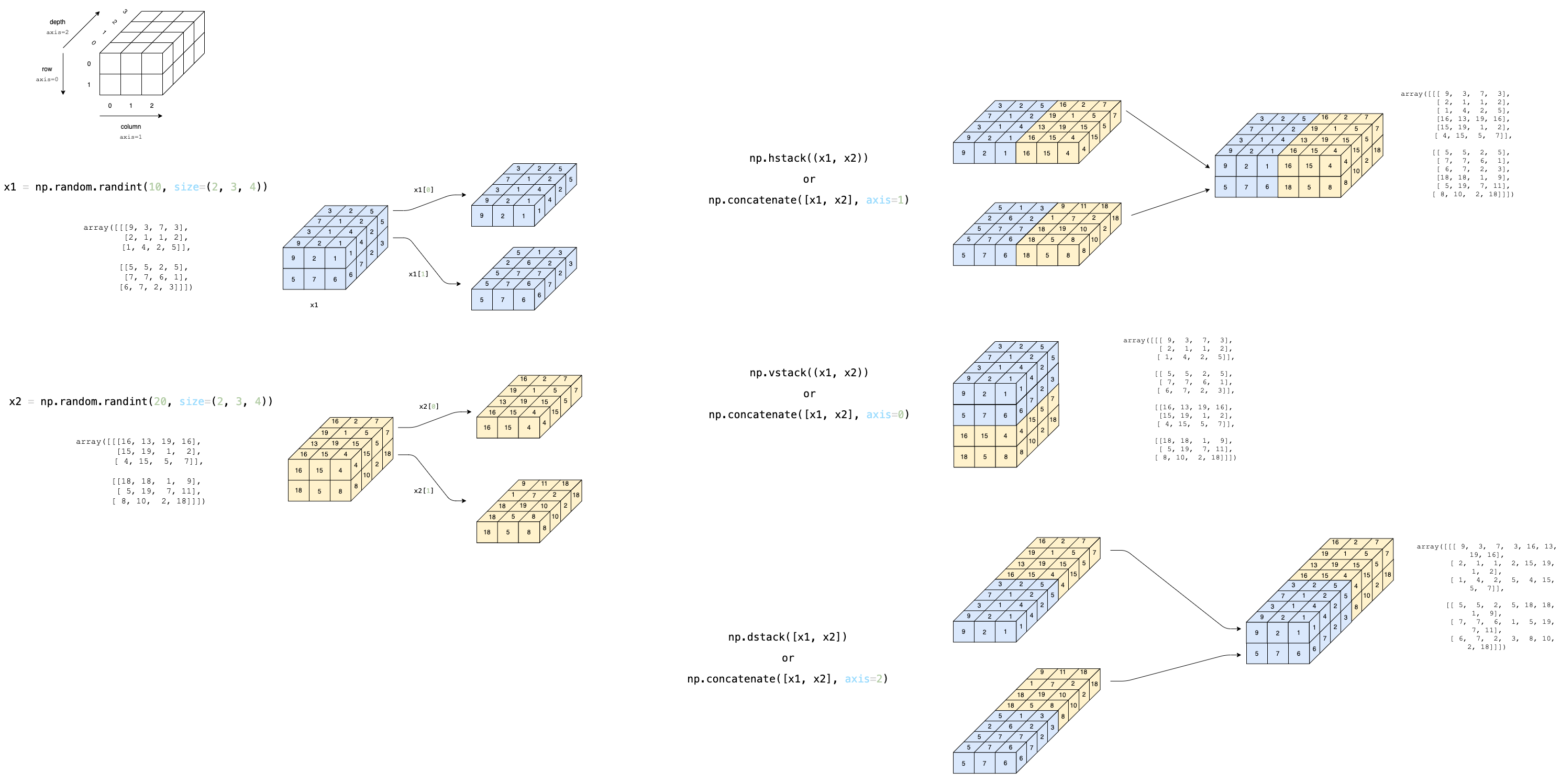Stack and Concatenate
TL;DR

Stack of Numpy array
Prepare Data
import numpy as np
x1 = np.array([[[9, 3, 7, 3],
[2, 1, 1, 2],
[1, 4, 2, 5]],
[[5, 5, 2, 5],
[7, 7, 6, 1],
[6, 7, 2, 3]]])
x1
array([[[9, 3, 7, 3],
[2, 1, 1, 2],
[1, 4, 2, 5]],
[[5, 5, 2, 5],
[7, 7, 6, 1],
[6, 7, 2, 3]]])
x2 = np.random.randint(20, size=(2, 3, 4))
x2
array([[[16, 13, 19, 16],
[15, 19, 1, 2],
[ 4, 15, 5, 7]],
[[18, 18, 1, 9],
[ 5, 19, 7, 11],
[ 8, 10, 2, 18]]])
np.hstack()
np.hstack((x1, x2)) # horizontally stack, equivalent to concatenate along column
array([[[ 9, 3, 7, 3],
[ 2, 1, 1, 2],
[ 1, 4, 2, 5],
[16, 13, 19, 16],
[15, 19, 1, 2],
[ 4, 15, 5, 7]],
[[ 5, 5, 2, 5],
[ 7, 7, 6, 1],
[ 6, 7, 2, 3],
[18, 18, 1, 9],
[ 5, 19, 7, 11],
[ 8, 10, 2, 18]]])
Equivalent to np.concatenate with parameter axis=1 (along column)
np.concatenate([x1, x2], axis=1) # concatenate along column
array([[[ 9, 3, 7, 3],
[ 2, 1, 1, 2],
[ 1, 4, 2, 5],
[16, 13, 19, 16],
[15, 19, 1, 2],
[ 4, 15, 5, 7]],
[[ 5, 5, 2, 5],
[ 7, 7, 6, 1],
[ 6, 7, 2, 3],
[18, 18, 1, 9],
[ 5, 19, 7, 11],
[ 8, 10, 2, 18]]])
np.vstack()
np.vstack([x1, x2]) # vertically stack, equivalent to concatenate along row
array([[[ 9, 3, 7, 3],
[ 2, 1, 1, 2],
[ 1, 4, 2, 5]],
[[ 5, 5, 2, 5],
[ 7, 7, 6, 1],
[ 6, 7, 2, 3]],
[[16, 13, 19, 16],
[15, 19, 1, 2],
[ 4, 15, 5, 7]],
[[18, 18, 1, 9],
[ 5, 19, 7, 11],
[ 8, 10, 2, 18]]])
Equivalent to np.concatenate with parameter axis=0 (along row)
np.concatenate([x1, x2], axis=0) # concatenate along row
array([[[ 9, 3, 7, 3],
[ 2, 1, 1, 2],
[ 1, 4, 2, 5]],
[[ 5, 5, 2, 5],
[ 7, 7, 6, 1],
[ 6, 7, 2, 3]],
[[16, 13, 19, 16],
[15, 19, 1, 2],
[ 4, 15, 5, 7]],
[[18, 18, 1, 9],
[ 5, 19, 7, 11],
[ 8, 10, 2, 18]]])
np.vstack([x1, x2]).shape
(4, 3, 4)
Note: for 1-D array of shape (N,), the array will be firstly reshape to (1, N)
a = np.arange(3) # [0, 1, 2], shape: (3, )
b = np.arange(4, 7) # [4, 5, 6], shape: (3, )
print(np.vstack([a, b]))
print('shape:', np.vstack([a, b]).shape)
[[0 1 2]
[4 5 6]]
shape: (2, 3)
np.dstack()
np.dstack([x1, x2]) # depth-wise stack, equivalent to concatenate along the third axis (depth)
array([[[ 9, 3, 7, 3, 16, 13, 19, 16],
[ 2, 1, 1, 2, 15, 19, 1, 2],
[ 1, 4, 2, 5, 4, 15, 5, 7]],
[[ 5, 5, 2, 5, 18, 18, 1, 9],
[ 7, 7, 6, 1, 5, 19, 7, 11],
[ 6, 7, 2, 3, 8, 10, 2, 18]]])
Equivalent to np.concatenate with parameter axis=2 (along depth)
np.concatenate([x1, x2], axis=2) # concatenate along the third axis
array([[[ 9, 3, 7, 3, 16, 13, 19, 16],
[ 2, 1, 1, 2, 15, 19, 1, 2],
[ 1, 4, 2, 5, 4, 15, 5, 7]],
[[ 5, 5, 2, 5, 18, 18, 1, 9],
[ 7, 7, 6, 1, 5, 19, 7, 11],
[ 6, 7, 2, 3, 8, 10, 2, 18]]])